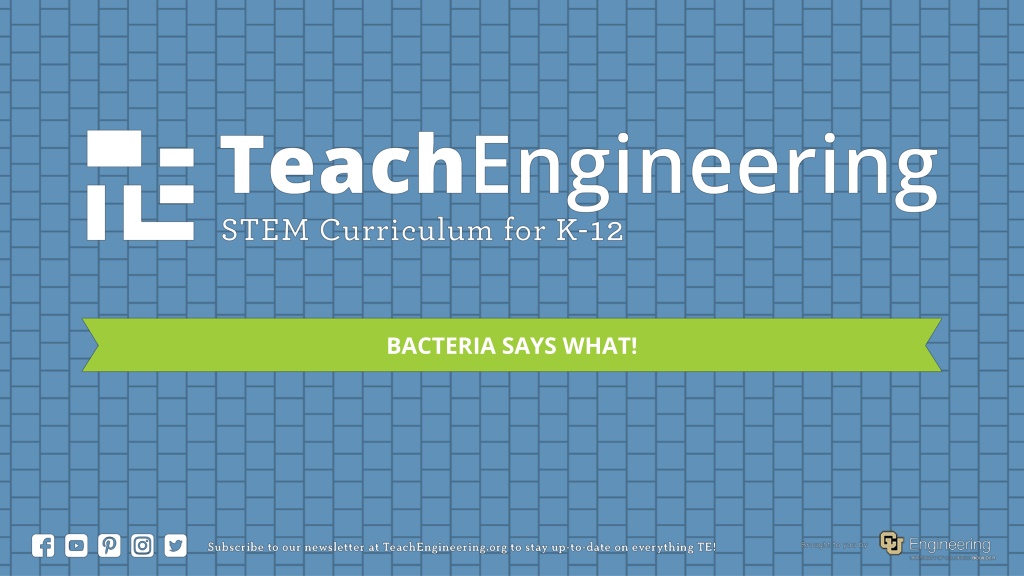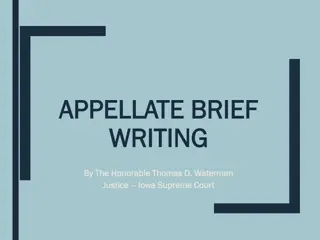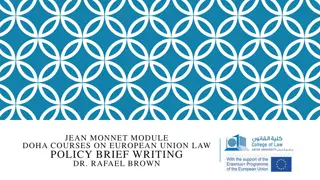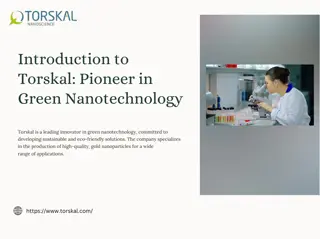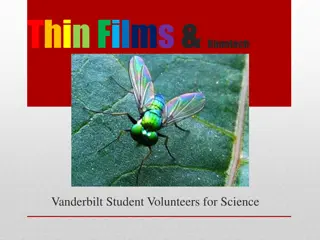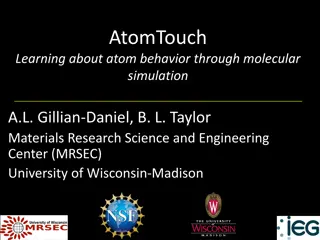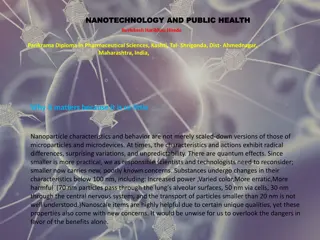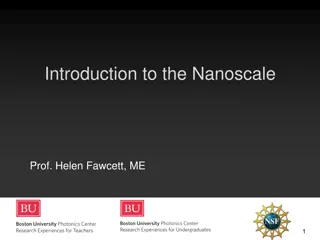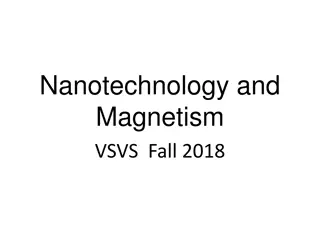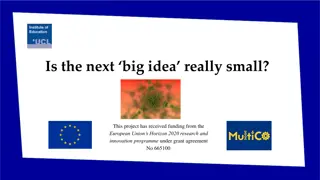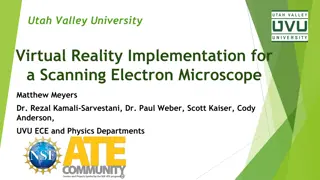Understanding Nanotechnology: A Brief Introduction to the World of Nanotech
Delve into the fascinating realm of nanotechnology through a concise overview provided by Andrew Maynard, an esteemed ASU professor. Explore the innovative possibilities offered by designing materials at the atomic level and the crucial aspect of responsible innovation in dealing with the implications of nanomaterials. Discover why awareness of nanotechnology is essential and how it impacts our lives. Uncover resources for further exploration in this cutting-edge field.
Download Presentation

Please find below an Image/Link to download the presentation.
The content on the website is provided AS IS for your information and personal use only. It may not be sold, licensed, or shared on other websites without obtaining consent from the author. Download presentation by click this link. If you encounter any issues during the download, it is possible that the publisher has removed the file from their server.
E N D
Presentation Transcript
Nanotechnology What is nanotechnology? A short introduction to nanotechnology, and why you should care about it - from author of Films from the Future and ASU professor Andrew Maynard. The video dives into materials science and advanced materials, and looks at how designing and engineering substances from the atoms they're made of upward allows novel properties to be developed and used. It also looks at responsible innovation when it comes to grappling with the benefits as well as the health and environmental risks of nanoparticles and nanomaterials. Stand-alone copies are available on request from Andrew Maynard at Andrew.maynard@asu.edu #nanotechnology #safety #risk #nano USEFUL LINKS NOVA nanotechnology resources: http://www.pbs.org/wgbh/nova/search/results/?x=0y=0q=nanotechnology Nanotechnology 101 from the US Government: http://www.nano.gov/nanotech-101 K-12 nanotechnology lesson plans, from NISE Net: http://nisenet.org/search/product_category/k-lesson-plans-15 Nano Me: Nanotechnology in our lives: http://www.nanoandme.org/home/ 24 questions and answers on nanotechnology safety: http://2020science.org/2010/02/12/24-questions-and-answers-on-nanotechnology-safety/ Nanotechnology basics from nanotechnology for Dummies: http://www.dummies.com/how-to/education-languages/science/Nanotechnology/Nanotechnology-Basics.html Nanotech rewards (video from Discovery): https://www.youtube.com/watch?v=yYXWHVZU0_g Nanotech risks (video from Discovery): https://www.youtube.com/watch?v=qc0KLV8CW08 ACKNOWLEDGEMENTS This video was developed as part of the NSF-funded Nanosystems Engineering Research Center for Nanotechnology-Enabled Water Treatment (NEWT), under NSF Award Number EEC-1449500. It was produced in collaboration with Claire Cook. RISK BITES Risk Bites videos are devised, created and produced by Andrew Maynard, in association with the Arizona State University School for the Future of Innovation in Society (http://sfis.asu.edu). They focus on issues ranging from risk assessment and evidence-based decision making, to the challenges associated with emerging technologies and opportunities presented by public interest technology. Risk Bites videos are produced under a Creative Commons License CC-BY-SA Backing track: Mandolin Highway by Olive Musique. http://www.premiumbeat.com/royalty_free_music/songs/mandolin-highway Risk Bites is your guide to making sense of risk. We cover everything from understanding and balancing the risks and benefits of everyday products, to health science more broadly, to the potential impacts of emerging technologies, to making sense of risk perception. If you enjoy our videos, please subscribe, and spread the word!
SAFETY SLIDE Lab Coat Safety Glasses Gloves Close-Toed Shoes Long hair tied back
Introduction Why is it you wash your hands before you eating and after using the bathroom? How many times do you think you have you touched your face today? Is there anything on the table in front of you? Is there bacteria in front of you on the table??
Synopsis Children are getting sick on a regular basis even though we could prevent many of these incidents. They need to know what is around them and how to handle the things around them they cannot see.
Making Agar Dishes 15 minutes to set: On the bottom of the petri dish, draw a line dividing it in half and label the sides for each partner
Nanoparticles What are nanoparticles ? This science video explains about nanoparticles. You will find the answers for; what are nanoparticles? how small they are ? can we see nanoparticles by our naked eyes? what are the differences between bulk materials and nanomaterials? why different nanoparticles of the same material have different colors? what is melting point depression? Please subscribe to "Science YOUniversity" for more science videos.
Our Nanoparticles! Titanium Dioxide - Absorbs ultraviolet light Places you can find titanium dioxide: sunscreen, paper, makeup, food, plastics, and rubber. Zinc Oxide - Pain relief Places you will find zinc oxide: rubbers, plastics, ceramics, glass, cement, lubricants,paints, ointments, adhesives, sealants, pigment, food, batteries, ferrites, and bandages.
Acquiring your sample: 1. Flip petri dish over and draw a line cutting the dish into fourths and label each side with initials. 2. Students will use their swab to take a sample of one item in the classroom. Each partner will then streak their half the dish. 3. Divide the dish into quarters. Apply a pinch of titanium dioxide to one quarter. On the other side put zinc oxide. 4. Close the petri dish and apply parafilm to seal the dish. 5. Place dish in incubator.
Making Observations 1. Create a data table in your notebooks. 2. Record observations of your petri dish. 3. 4. - Observations should include color, shape, size, and any other interesting characteristics 5. Use the image to the right to assist with descriptions. 6. Compare your quarters with and without titanium dioxide/zinc oxide.
Discuss your Bacteria! 1. Compare your bacteria to your partners, including how are they alike, how are they different, and how the titanium dioxide affected their samples. 2. Find another pair oto share and discuss their results. 3. Complete the Exit Ticket! 4. Extension: Utilizing the internet discover what type of bacteria is on your petri dish along with what its purpose is.
Bacteria Links Quick Follow-up Article #1 The Five Dirtiest Things You Touch Everyday Follow-up Article #2 Your Towels Are Way Dirtier Than You Think Follow-up Video Cell-like nanorobots!
